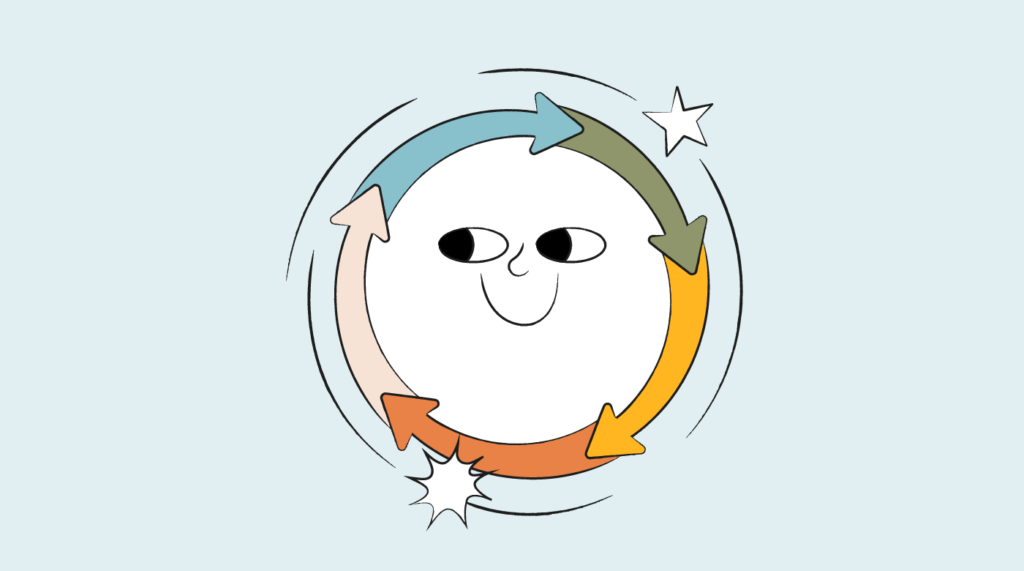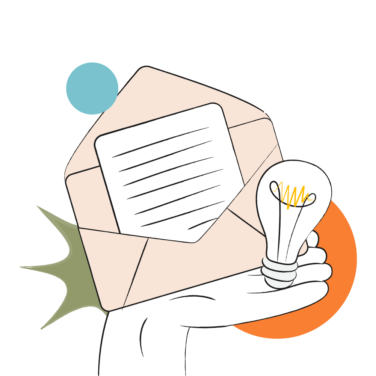I can only assume you're here because you, like so many, are curious about product-led growth (or PLG)—and specifically, the mechanisms that make it such a successful strategy. If I'm correct in my assumption, the product-led growth flywheel is an essential piece of the puzzle.
Why is it worth learning as much as you can about PLG? Because in the last decade, companies prioritizing product experiences outperformed their peers on the S&P 500 by 219%.
In many ways, PLG resembles what a skilled wordsmith tries to do—weaving captivating stories to charm readers (I hope you’ll put me in that category one day), so they keep coming back and start evangelizing about their favorite storyteller to all who will listen.
In this article, you’ll get it all. Expect a comprehensive overview of product-led growth, the flywheel model, and a real-life example of a product-led company and the practices they use to reach market dominance.
The Methodology Behind Product-Led Growth (PLG)
Product-led growth is a growth strategy centered on crafting a product that meets user needs, lets them experience product value independently, makes them fall in love with it, and motivates them to share their positive experiences with others.
It’s about using your product itself as the engine for growth, resulting in a more customer-driven and sustainable approach to expanding your product's success.
This means that you’re not only trusting how awesome your product is — I assume you're confident enough about that!—but are constantly working on improving it.

What Is The Product-Led Growth Flywheel?
The PLG flywheel is a simplified visualization of how the different elements of a PLG strategy interact to drive continuous and self-sustaining growth.
It contains two rings that, combined, wield immense power (I'm pretty sure Gollum would have lost his sh*t!).
The inner ring contains the Segments, and the outer ring contains the Actions.

Product-Led Growth Flywheel Segments
When I think of the segments, I can't help but reminisce about high school. Let me explain why—and you tell me if it makes sense.
Strangers
I remember the first days (and weeks) of high school, being excited and scared at the same.
In the beginning, most classmates were strangers. Strangers that I hoped would someday become my friends — at least some of them. My goal was to see who they were and if my character and goals were compatible with theirs—basically, I was looking to discover my "people."
If you have a new product, you’ll face a similar challenge. Strangers will pass by, and some of them will be a great fit for your product. Your goal is to turn them into explorers.
Explorers
Back to those first weeks at high school. I remember trying to figure out whom to form friendships with. At the same time, I tried to present myself in the best way. You know how it goes—you observe, interact, ask questions, and see what you have in common. You try to see where you fit in and who is drawn to you.
When it comes to your product, strangers explore it. They’re curious to learn more about your offering, features, and capabilities. It’s crucial to provide them with a smooth onboarding experience and showcase the value your product offers, to transform them into beginners.
Beginners
A few weeks later, I started hanging out with classmates. After having tested the waters, it was time to really get to know each other better. It was time to show people my true self, engage with them on a deeper level, and become close friends.
For your product, it's the same journey. Those who start using it need to have intuitive features and resources made available to them to help them understand its benefits and how to use it effectively. As beginners gain confidence, they become regulars.
Regulars
By hanging out more often with my new friends, I soon found out which of them I 'clicked' with the most. We started hanging out more, with the goal of one day becoming best friends through thick and thin.
When it comes to your product, this is where new users become your regular customers. These customers are familiar with your product and use it consistently. To maintain a high level of retention, your product should ongoingly offer them more value and address their needs. Do it right, and their positive experiences will encourage them to become your champions.
Champions
That brings us to the final stage. My closest friends would bring me up in conversation with their other friends, telling stories about fun times we had together and inviting them to hang out with us next time we got together.
Your product should help users achieve their goals. When they succeed and achieve their desired outcomes using your product, they become advocates. They spread positive word of mouth, refer others, and contribute to the organic growth of your product.
Whew, now I'm really feeling nostalgic. Let's move on!
Product-Led Growth Flywheel Actions
Now, let’s take a look at how to get users from one segment to the other by using the Flywheel actions.
If you get overwhelmed, remember that lots of great PLG software is out there to help you out.
Evaluate: From Strangers to Explorers
This stage involves actions to attract potential users, capture their attention and introduce them to your value proposition. Once you attract these “strangers,” you can guide them through the subsequent stages with suitable actions.
There are several strategies that you can apply.
Early on:
- Social media & community engagement: Use social media platforms to share informative content, engage with your audience, and create a community around your product.
- Content marketing: Create high-quality content that addresses the pain points and needs of your target audience. Think blog posts, videos, infographics, workshops, webinars, e-books, and other free tools and resources that provide valuable insights.
- Public relations (PR): Share your product’s story and achievements through press releases, media coverage, and interviews. PR raises awareness and credibility.
Later (once you're more established):
- Targeted advertising: Run targeted digital advertising campaigns and consider collaborating with influencers and thought leaders to reach specific user segments likely to be interested in your product.
- Partnerships and collaborations: Partner with complementary products to tap into their user base. Cross-promotions and collaborations are neat ways to introduce your product to a wider audience.
- Search engine optimization (SEO): Optimize your website and content for search engines so that your product is discoverable when potential users search for relevant keywords or phrases.
Activate: From Explorers to Beginners
When you look to convert explorers into beginners, it's all about the 'Aha!' moment. It's about the user journey, and how those who are exploring your product’s features and benefits can experience value as quickly as possible. Doing well in this arena gives you a great shot at improving your conversion rate.
You can implement the following strategies when onboarding explorers, which I like to call F.U.N (Focus, Undergo, Navigate).
Focus
- Feature highlights: Highlight the most valuable features of your product that align with the user’s needs and pain points. Provide clear explanations and demonstrate how these features can benefit them.
- Personalized experiences: Tailor the customer experience based on individual preferences and needs. The data you’re collecting will also help you understand your users' behavior and provide relevant content and functionality.
Undergoing
- User-centric onboarding: An intuitive and user-friendly onboarding process that allows users to understand the workflow to solve their problems quickly.
- Progress tracking: Show users their progress as they explore the product. It motivates them to continue their journey and discover more value.
- Gamification elements: Incorporate gamification elements, such as badges or rewards, that encourage users to explore different parts of the product. This makes the exploration process more engaging.
Navigation
- Interactive tutorials: Offer interactive tutorials, tool tips, and guided tours that walk users through the product. These things help make exploration more efficient and decrease time-to-value.
- Help center and documentation: Provide comprehensive documentation, FAQs, and a robust help center. This ensures that users have resources to assist them.
- Customer support: Offer responsive customer support channels where users can get assistance. A positive support experience improves the perception of value.
Adopt: From Beginners to Regulars
Gimme gimme (more), gimme (more),
-Britney spears
gimme gimme more,
When it comes to a product-led growth strategy, Britney's immortal words hold true for both your product and your customers.
To turn beginning users into regulars, use the following strategies.
- Success metrics and milestones: This one builds on the gamification strategy. Define key success metrics that align with users’ goals and help them track their progress in-app. Celebrate milestones and achievements, reinforcing their sense of accomplishment.
- Personalized recommendations and exclusive content: Offer recommendations and access to exclusive content, resources, or events that provide value beyond what’s available to beginners.
- Continuous learning: Provide ongoing learning resources, webinars, or workshops to help regular users stay updated on new features and best practices.
- Recognition and rewards: Acknowledge and reward regular users for their loyalty and engagement. This creates a sense of belonging and motivates them to keep coming back.
- User communities: Foster user communities where regular users connect, share insights, and exchange tips.
- Engagement surveys: Conduct surveys to gauge user satisfaction and gather insights on how you can enhance user experience further.
Expand: From Regulars to Champions
The best regulars are the existing customers who champion your product and create a new following.
You can get them there using the following strategies.
- Recognition and spotlight: More than ever before, people like to share and show off their professionalism and skills. Highlight champions in your marketing materials, website, and social media. Feature their stories and successes prominently. This demonstrates real-world value and turns them into the champions that advocate your product.
- Feedback and co-creation: Involve regular users in product development by seeking feedback and ideas. This not only improves your product but also strengthens their connection to it.
Advocate: Empower Champions to Drive Growth
Sure, doing work is good, but have you tried letting other people do your work for you? It's amazing. Especially when it’s mutually beneficial.
The following strategies help you to get your champions to drive growth.
- Referral incentives: Implement a tiered referral system where champions earn escalating rewards for each successful referral. This incentivizes them to actively refer new users.
- Champion programs: Formalize a champion program that recognizes and rewards your most enthusiastic advocates. Provide exclusive benefits, early access to updates, special badges or designations, and (if you can), special events.
- Advocate kits: Create kits containing pre-written testimonials, case studies, and marketing materials that champions can use to consistently promote your product.
- User-generated content: Encourage champions to create and share content, such as blog posts, videos, or social media updates showcasing how they use your product.
Case Studies Of The PLG Flywheel In Action
In a previous article, I waxed poetic about six shining examples of product-led growth done right. For this one, let’s deep-dive into one company and look at their PLG flywheel efforts.
Social Sprout: A PLG Case Study
Social media engagement is a hot topic, so let’s find a SaaS in this field and explore their product-led flywheel.
Capturing the attention of strangers to explore
Googling a bit, Sprout Social pops up both in the “top” and “best” lists and ranks high in Google as a solution. Their SEO game is on point.
You’ll also find them on major social media platforms, posting regular content to attract potential customers.
Regarding partnerships and collaborations, they have recently upped their game by acquiring Tagger Media, and their PR game is on point, too.
Getting the Explorers to Begin
Sprout Social’s website immediately attracts attention with its value proposition that speaks to customer needs.
At various moments, they encourage you to sign up for a trial, including an exit-intent pop-up encouraging you to start a free trial.
The free trial allows users to experience features from three of their four plans, without needing a credit card.
The sign-up and product onboarding is user-centric and straightforward. It includes an e-mail welcome, links to tutorials, and a guided onboarding aimed at reaching the 'Aha!' moment ASAP.
Sprout Social uses a progress tracking bar to motivate users to continue the journey and discover more value.
Evolving Beginners to Regulars
A help center and customer success team form the basis of this play. To help beginner users learn and engage more, Sprout offers online seminars.
Sprout Social also uses models to nudge users to trial more features from higher plans, with the objective of ticking up their customer acquisition rates and product adoption.
Additionally, from what I have experienced using this tool:
- They use e-mail follow-ups and subtle in-product nudges to encourage users to explore and use more features.
- They highlight collaboration tools and engagement features that encourage you to involve team members, which results in regular product usage as they work together on social media campaigns.
- They steadily announce new features, while mentioning their benefits and how to set them up.
- I'm also fond of the plan upgrade message. It truly feels like you unlocked a new 'skin' or level in a game, which encourages you to do more.
Creating a League of Champions
With a focus on advocacy, Sprout Social empowers users to become champions through:
- Partnership programs—so you can get some dollar dollar bills, y’all!
- Tons and tons of case studies.
- Support from certified agency partners. Though, technically, the agency partners are not regulars that become champions, they can only become an agency when they are true Sprout Social experts — so I’ll allow it.
All In All
As we near the end of our lovely article about the PLG flywheel, remember that its power lies not just in its conceptual brilliance, but in its real-world impact on companies large and small.
By embracing the principles of product-led growth and nurturing each stage of the flywheel, you can acquire sustained success, user-driven innovation, and a future where your product not only shines but thrives.
So, as you embark on your own growth journey, or transitioning from Sales-Led to Product-Led, may the PLG flywheel guide you, inspire you, and empower you to shape your product’s success.
Enjoyed this article? Get more expert insights and product management resources delivered to your inbox by subscribing to our newsletter.


